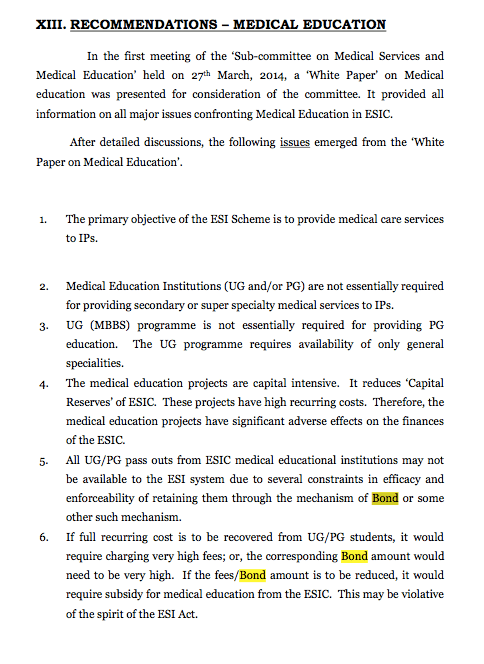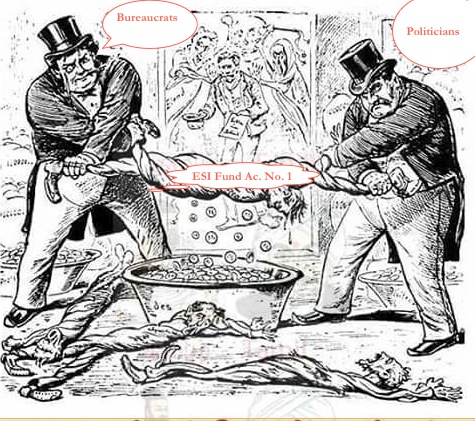The ESI Corporation Minutes dated 17.07.2007 shows that the decision to open medical colleges had been taken in that meeting, in spite of the fact that there was no formal agenda on that subject and no discussion on that subject. The Sub-Committee that was constituted, later, in 2008 to formulate proposal for amendments on various issues, recommended setting up medical colleges on the condition that the “doctors and paramedical staff would be required to render such minimum service in ESI hospitals / dispensaries / institutions as may be decided by the Corporation”.
The Insured Persons whose money was to be spent for this purpose and the Parliamentarians who approved the amendment to insert Sec. 59-B had been given the impression that there was something for the Insured Persons in return for the money collected from them (whether it was proportionate or not is beside the matter).
As the intention was only to fritter away and misappropriate the surplus funds, the authorities did not wait for the essential procedure of formal amendment to the ESI Act, which actually came in the form of Sec. 59 B of the Act only in May 2010 effective from June 2010. They initiated the construction work for so many medical institutions throughout the nation, in a tearing hurry, in the year 2008 itself, and spent about Rs. 10000 crores even before the Act was amended. They did not exhibit ordinary prudence and caution by having a proper and objective in-depth study of the pros and cons of starting medical institutions by the ESI Corporation. They did not even try with a few pilot projects. They started constructing buildings, at one go, for large number of medical colleges including nursing colleges and colleges for para medical staff.
There was never any felt need for the ESIC to start medical colleges to recruit the MBBS-qualified doctors let alone nurses and para-medical staff to run their dispensaries and hospitals. The ESI Corporation had always been getting overwhelming response to its advertisements to recruit MBBS-qualified doctors, BDS qualified doctors, nurses and other para-medical staff. For instance, there had been 3000 applicants when the recruitment process was for 300 vacancies of MBBS-qualifed doctors. Yet, the authorities started constructing about 23 buildings throughout the nation and all of them have now become white elephants. Now, in the year 2014, their own Sub-Committee on Medical Services & Medical Education said that running the medical colleges would result in the budget becoming negative in the year 2016-17.
Hon’ble Minister for Labour Mr. Narendra Singh Tomar has said that “the decision to open medical colleges by the ESIC was a big mistake”.
Calling the ESIC board’s decision to open medical colleges in 2008-09 a “big mistake”, labour and employment minister Narendra Singh Tomar said he will review the scheme.“The decision to open medical colleges by ESIC was a huge mistake and we will rectify it,” Tomar told reporters after a meeting of the ESIC board comprising representatives of workers, industry and government.
The Financial Commissioner said that the ESIC did not have the core competency:
“Medical education is not our core competency, and we would prefer to focus on our primary job—providing medical care services to industrial workers,” said S.K. Rahate, finance commissioner, ESIC. “We have learnt from experience over the last five years.”
Live Mint reported:
“These are high cost projects causing a significant outflow of funds on both capital as well as revenue accounts. This will in near future cause the ESIC expenditure to be more than its revenue income,” said an internal note based on an ESIC sub-committee report. Mint has seen a copy of the note.”
That Note, the Report of the Sub-Committee on Medical Services & Medical Eduction submitted in May 2014 discussed at length about the system of Bond that had to be obtained from the students who were given subsidised education from the ESI Funds. In Para XIII (6) in Page 51 of the Report, the Sub-Committee had observed that the ESIC could not subsidise the medical education, when the Bond was not for recovering the full recurring cost. The said para read as under:
“If full recurring cost is to be recovered from UG/PG students, it would require charging very high fees; or, the corresponding Bond amount would need to be very high. If the fees/Bond amount is to be reduced, it would require subsidy for medical education from the ESIC. This may be violative of the spirit of the ESI Act.”

In Para XIII (5) (e) of the Report, the Sub-Committee had said, “That there was no system of bond enforcement and without an effective enforcement of bonds, the availability of doctors to the Corporation would not be assured.”
Now, all of a sudden, the insured persons are informed that the so-called precautions taken by them, as narrated above, can be and have been thrown to wind.
This announcement is made even before the first batch of undergraduate students is out and on the verge of their being out, by the summer of 2016. The ESIC does not say that there is no vacancy to accommodate the newcomers. The ESIC says that obtaining such bonds would be considered as anti-people move.
“Since ESIC has spent thousands of crores on medical colleges, it is unfair for students who get subsidized education and then join the private sector, a labour ministry official said. “So, the Rs.25 lakh bond plan was mooted, but in the current political environment, such a move has been put on the back-burner,” the official said, requesting anonymity.” (http://www.livemint.com/Politics/yJigrCBGE3RY3oBhGp7A2H/Govt-scraps-planned-Rs25-lakh-bond-for-ESIC-medical-students.html)
This is not a correct decision. The reason publicly proclaimed does not appear to be the right one. The money of the Insured Persons cannot be frittered away by the politicians and bureaucrats thus.

Such an awakening that the enforcement of Bond would be seen as an anti-people move did not come in 2007 or 2008, before venturing into the area of medical education. Besides, such Bond system is in vogue as per the CCS (Leave) Rules, 1972, governing the sanction of even the Study Leave. Nobody has termed it as an anti-people move, during the past 43 years.
In the circumstances, some Insured Persons are already taking action to move the Hon’ble Court to seek its intersession, against this kind of arbitrary decision in the name of Policy Decision.
The copies of the Agenda and the Minutes of the meeting of the ESI Corporation in which such a decision has been taken have, therefore, been sought for under the RTI Act. But, if any of the readers happen to have those documents, through the ESIC Members, they may kindly transmit the same to this website to facilitate early legal action, in the interest of the working population.
Readers may also evaluate for themselves the manner in which benefits made available to the Insured Persons have been reduced post 2010.
1). http://www.outlookindia.com/article/the-gurney-grinds-to-a-sad-halt/295143
2) https://flourishingesic.info/2012/09/27/enigmatic-amendment-2011-that-affect-the-benefits/
3). and the response of Ms. Nisha Parveen below the thread referred to supra.


One assertion that ‘benefits have been curtailed post 2010’ is not correct. In fact the very focus of most of the officers of the organisation had/have largely been on revenue (probably because it gives power during collection) and harassment of own colleagues by ‘various types of objections/observations’ (this might be giving pseudo feeling of super human to the objectors). Percentage of officers caring to ensure reaching of due benefits to the insured employees as per objects and purpose of the ESI Act has been negligible or invisible. Hence the sin money got accumulated. Even now there are states where out of over 2 dozen implemented centres there is not even arrangements of primary medical care (or secondary, etc) in a dozen centres, there is no established /working system of even reimbursements, some reimbursements are made @CGHS (Why?, Is ESI SCHEME CGH SCHEME? ). IPs might be virtually loses in this Scheme, what if the money so collected and accumulated is frittered? Pain of IPs is more severe than anyone else. Please do research on that and write, money will not accumulate for frittering.